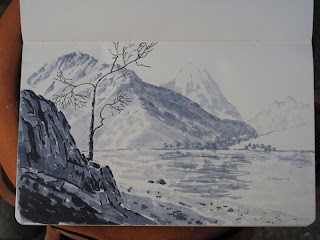The name Turner inspires all sorts of feelings amongst those of us who take pleasure in painting and it came up as it often does in a recent conversation with one of my gurus, Martin Kinnear. "Have you been up to Edinburgh recently? Turners galore". This was how he introduced the subject. In fact he was letting me know about the exhibition currently running at the National Gallery of Scotland, 'Turner and Italy'. With little further ado the web site was checked, the partners in crime contacted and the date was set for the day's excursion to Edinburgh. Fortunately for us Edinburgh is a shortish train ride away from home and Jed, Pat and myself met up early to take the rail up to Scotland's capital.
To say that the rest of the day was a feast illuminated by the glow from the gallery walls would be to undersell the wonders on display. The exhibition covered the whole of Turner's career and would be a wonderful introduction for anyone wishing to trace his development and growth into the marvel responsible for his transcendent later works. The early works, prior to his first trip to Italy were fine pieces of their time, as exemplified by the painting below.
 Dolbadern Castle
Dolbadern Castle - J.M.W. Turner
Royal Academy of Arts
Examples then followed of a number of landscape styles, echoing some of the great names of European art like Claude. Watercolours, sketch books fleshed out the understanding of how Turner developed and prepared for his painting. Fascinating, but not as revelatory as the clear shift in how he interpreted his preparatory work into worked up paintings. Maybe the next two paintings give some feeling of that when we see similar landscapes in dramatically different treatments.
 The Dogana and San Giorgio Maggiore
The Dogana and San Giorgio Maggiore - J.M.W. Turner
National Gallery of Art, Washington
 Dogana and Santa Maria della Salute
Dogana and Santa Maria della Salute - J.M.W. Turner
National Gallery of Art, Washington
The shift in style that takes place from the first of these to the second is dramatic and presages the mighty works that were to follow. There is another view exhibited, that I've not been able to get a satisfactory image of, that is mind blowing. At first glance the canvas looks almost white, but emerging from the brilliance is the most subtle rendition of the view that is depicted above. Whilst I haven't tried it you could probably get an approximation by photoshopping the above image and then removing colour and contrast. Somewhere in there might be a hint as to what Turner achieved. Jed christened this painting the 'White Album', yes he's a musician. Pat is also full of musical allusions and his comment about the style shift was 'Turner's Crossroads' moment.
The extreme example referred to clearly informs much of the later work exhibited. The next painting does away with much detail yet still communicates detail in the sensual textures and brushwork.
 Landscape with River and Bay in the distance
Landscape with River and Bay in the distance - J.M.W. Turner
Musee de Louvre
Another interesting factor in viewing a collection of Turner paintings is the way in which he often shifts the focus of the composition towards the centre. I have posted examples of this before where the clear vortex design dominates the painting. Often the centre of his work is the quietest passage rendered in soft tones whilst there is great activity around the edges.
The next picture is one that is used in the catalogue to exemplify the way that Turner would rework older paintings to reflect different taste as his work grew and developed.
 Wreck Buoy
Wreck Buoy - J.M.W. Turner
Sudley House
Finally the last picture in the exhibition titled after a place where Turner had sketched and painted on all of his trips to the continent. It was on his way across land to Italy. It epitomises the facility that he had to depict both climactic conditions but the truth of landscape as a funciton of the light.
Having spent the morning in the exhibition and then taken lunch there was nothing else to do but spend the rest of the day back with JMW before heading back for the last train.
 Val d'Aosta
Val d'Aosta - J.M.W. Turner
National Gallery of Victoria, Melbourne
 Aira stream - Oil on canvas board 12" x 10"
Aira stream - Oil on canvas board 12" x 10" Ennerdale - Watercolour on Not paper
Ennerdale - Watercolour on Not paper











